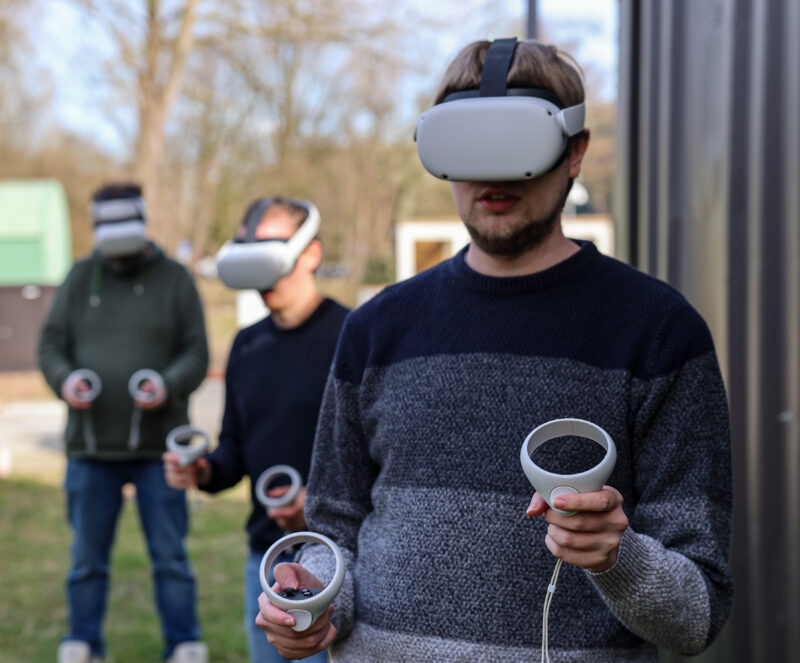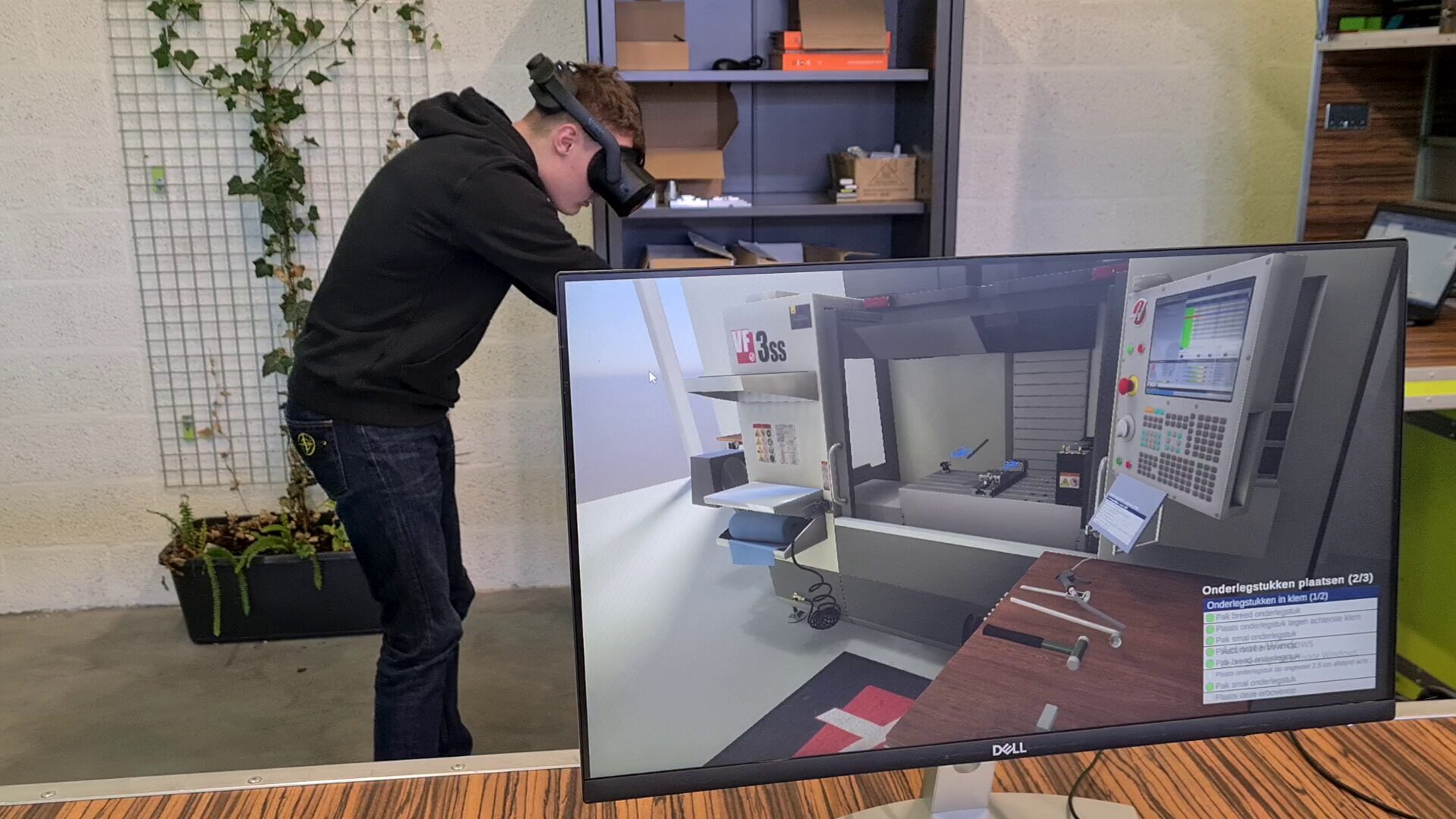How can virtual reality contribute to the education of the future? With over 27,000 students and more than 60 buildings, you could consider TU Delft to be a splendid environment for developing and testing innovations. So a use case was quickly conceived, when Do IoT Fieldlab wanted to look into the application of IoT within education and research.
Within the NewMedia Centre at TU Delft, Jeroen Boots and Luuk Goossen focus on VR (virtual reality) and XR (extended reality). Together with Tim Kok of collaboration partner Surf they investigated step step by step how 5G can contribute to new applications in education. The main topic: how can we provide education to 400 students with the help of VR? What do we need and what are still stumbling blocks?
Luuk: “We basically looked very practically at what is needed in the future. First we investigated theoretically what will be required. 5G offers attractive solutions on paper. The response time is very fast. We are moving from tenths of milliseconds to hundredths of milliseconds. In addition, the bandwidth goes up to 100 times compared to 4G. So you can connect many more devices over a network simultaneously. We have our own 5G test facility at the Do IoT Fieldlab, on TU Delft campus. We can customize that network exactly the way we want. So you can probably imagine, we couldn’t wait to actually get into this.
Short response time and huge calculations
The research team wanted to test with an application that would merge all aspects. First of all, it involves interaction between – initially – two people in a virtual world. As part of this, they have to perform a task that is extremely precise in terms of movement, time and place. The team came up with what might sound like a simple solution: throwing a ball. In the application, both people have to see each other and interact. The slightest delay or glitch has an immediate effect: you throw inaccurately or you miss while catching. “This was the first part of our experiment. We knew: if this is successful, we will meet most of the requirements for future education,” Luuk explains.
The second part of the experiment concerned the performance and robustness of the network, making 5G applications useful in scientific research as well. As an example, Luuk mentions a study of black holes in space. The current processors in VR glasses are similar to those in a smartphone. Luuk outlines: “For powerful computations in VR simulations, you will need far more powerful computers than what glasses can provide. You could, for example overcome this by connecting four people by wiring the connecation to a computer for the extra computing power. But can you imagine if we wanted to connect 400 students in a lecture hall to the VR world? Then we’re spending a month relocating the equipment to connect everyone! So we are looking at using a virtual server, with all calculations taking place in a data center. So for each issue, we keep searching for a solution, aiming to measure as objectively as possible what the performance is, when we vary the research setup slightly.”

Tunnel and shaking hands
Most VR applications are built to be used at home and not over the mobile network. At TU Delft, the research team tested with 5G and with Wifi6. To ensure that only authorized users can access their own environment and exclusively see each other, a digital tunnel was built between two devices. This proved fine in the fieldlab, but in future, providers will not facilitate this on a public network. That led to the idea for another solution: a website that interconnects users. “The users can virtually meet in this space and shake hands and get acquainted. You wouldn’t have to be on the same network. The website is more like a kind of interpreter, connecting players, students, teachers or scientists; depending on the type of application. We are also looking for solutions to make data traffic more efficient. For 400 students, you basically need 400 virtual computers. Or could we manage 1 computer to run 400 sessions simultaneously? How does a network respond to that? Solving these kinds of issues is obviously very relevant.”
In classical academic education, a great deal of time is spent in lecture halls. For some students, actually performing or experiencing something themselves is more instructive than taking notes. The information is better retained that way. In addition, VR opens a variety of new doors. Consider experiments or exercises that would be unethical or dangerous to perform in real life. “You can tell students in a lab that it’s dangerous to mix two substances. In a VR simulation, they can actually witness what happens, for instance an explosion. And they can actually practice these situations. What exactly would you do when things go wrong? Just like a pilot in a simulator, you can practice several times and also discover how you and others react in a stress situation. We see an increasing demand for these types of applications in business. Like in marine engineering, for example. In some experiments, employees are merely permitted to observe. In a virtual shipyard, everyone can actively participate. In a couple of years, the technology will have reached the point where entire industries will be using it.”
Pausing the speed of light
Luuk also sees many more possibilities within TU Delft in the area of practicums. Such as in architecture: walk through your own building to see where you can improve the design. Or in physics. “Someone recently had the idea of slowing down a process happening at the speed of light in such a way that you can actually see what is occurring. You can actually play a physical process, slow it down, speed it up, or pause it. And you are standing right on top of it. The possibilities are endless. Didactically, I see great added value. Therefore we are very motivated to continue developing in this field. We can currently exercise with small groups of about 25 or 30 students. We want to scale it up to about 400 students working together at the same time. We have already tested with the future 5G technology. Do IoT Fieldlab has given us access to the 5G infrastructure; which will be available in the Netherlands in a few years. We literally tested in the field and it is ideal that we can walk up there ourselves in order to adjust the settings. That has definitely accelerated this development.”
Although this project is now completed, there are plenty of ideas and plans for follow-up research. Luuk views the future brightly. “We are far from being out of learning and out of development. In any case, we definitely want to develop the ‘handshake application’ and get it working properly. Security is the major issue here, to exclude hacking options. Furthermore, we want to optimize the data center. The results with a local virtual server were satisfactory, but with a remote server, the connection sometimes failed. We can’t yet exactly explain why. In the end, we want to explore solutions that can be widely applied in society. Thus, suppose you are doing research in a local community center, can you use 5G instead of having to look for a reliable local network? Ideally you want to use a configuration that has already been proven to work, so you don’t have any surprises.” In conclusion, there is plenty of exploration and research work ahead. Preparations for future studies are in full swing. Do IoT Fieldlab will continue to support these research efforts whenever possible, by providing advice and bringing together partners within and outside the TU Delft Campus ecosystem. One of these partners is the recently TU Delft startup, founded by Luuk: Dash XR.

